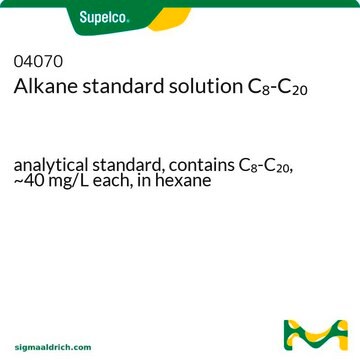146870
Heptanoic acid
96%
Synonim(y):
Enanthic acid, Oenanthic acid
About This Item
Polecane produkty
gęstość pary
4.5 (vs air)
ciśnienie pary
<0.1 mmHg ( 20 °C)
Próba
96%
Postać
liquid
granice wybuchowości
10.1 %
współczynnik refrakcji
n20/D 1.4221 (lit.)
tw
223 °C (lit.)
mp
−10.5 °C (lit.)
rozpuszczalność
water: soluble 0.2419 g/100ml at 15 °C
DMF: soluble
DMSO: soluble
diethyl ether: soluble
ethanol: soluble
gęstość
0.918 g/mL at 25 °C (lit.)
ciąg SMILES
CCCCCCC(O)=O
InChI
1S/C7H14O2/c1-2-3-4-5-6-7(8)9/h2-6H2,1H3,(H,8,9)
Klucz InChI
MNWFXJYAOYHMED-UHFFFAOYSA-N
Szukasz podobnych produktów? Odwiedź Przewodnik dotyczący porównywania produktów
Opis ogólny
Zastosowanie
Hasło ostrzegawcze
Danger
Zwroty wskazujące rodzaj zagrożenia
Zwroty wskazujące środki ostrożności
Klasyfikacja zagrożeń
Acute Tox. 4 Inhalation - Eye Dam. 1 - Skin Corr. 1B - STOT SE 3
Organy docelowe
Respiratory system
Kod klasy składowania
8A - Combustible corrosive hazardous materials
Klasa zagrożenia wodnego (WGK)
WGK 1
Temperatura zapłonu (°F)
235.4 °F - closed cup
Temperatura zapłonu (°C)
113 °C - closed cup
Środki ochrony indywidualnej
Faceshields, Gloves, Goggles, type ABEK (EN14387) respirator filter
Certyfikaty analizy (CoA)
Poszukaj Certyfikaty analizy (CoA), wpisując numer partii/serii produktów. Numery serii i partii można znaleźć na etykiecie produktu po słowach „seria” lub „partia”.
Masz już ten produkt?
Dokumenty związane z niedawno zakupionymi produktami zostały zamieszczone w Bibliotece dokumentów.
Klienci oglądali również te produkty
Nasz zespół naukowców ma doświadczenie we wszystkich obszarach badań, w tym w naukach przyrodniczych, materiałoznawstwie, syntezie chemicznej, chromatografii, analityce i wielu innych dziedzinach.
Skontaktuj się z zespołem ds. pomocy technicznej











